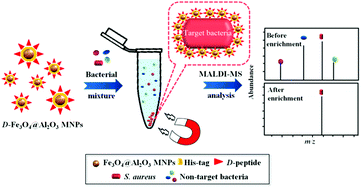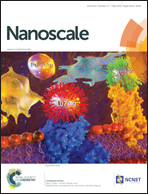Affinity capture using peptide-functionalized magnetic nanoparticles to target Staphylococcus aureus†
Abstract
Staphylococcus aureus, a commonly found pathogen, can cause food poisoning and infections. Thus, it is necessary to develop analytical methods for the rapid screening of S. aureus in suspicious samples. Magnetic nanoparticles (MNPs) are widely used as affinity probes to selectively enrich target species from complex samples because of their high specific surface area and magnetic properties. The MNP surface should be functionalized to have the capability to target specific species. We herein propose a straightforward method to functionalize aluminum oxide-coated iron oxide (Fe3O4@Al2O3) MNPs with the peptide HHHHHHDEEGLFVD (D). The peptide D was comprised of three domains: polyhistidine (H6) used as the linker, DEE added as the spacer, and GLFVD used for targeting S. aureus. D was immobilized on the surface of Fe3O4@Al2O3 MNPs through H6–Al chelation. Our results showed that the D-functionalized Fe3O4@Al2O3 MNPs (D-Fe3O4 MNPs) possess the capability to target S. aureus. The selective trapping experiments were conducted under microwave-heating for only 60 s, and sufficient bacterial cells were trapped by the MNPs to be identified by matrix-assisted laser desorption/ionization mass spectrometry (MALDI-MS). We demonstrated that the D-Fe3O4@Al2O3 MNPs combined with MALDI-MS can be used to rapidly characterize trace amounts of S. aureus in complex juice and egg samples.


 Please wait while we load your content...
Please wait while we load your content...